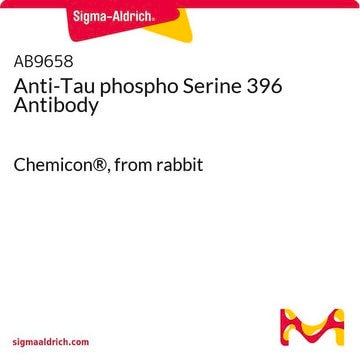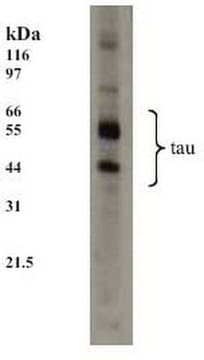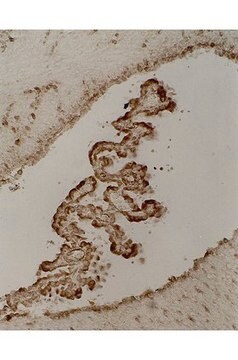AB9652
Anti-Tau phospho Serine 199 Antibody
Chemicon®, from rabbit
Sign Into View Organizational & Contract Pricing
All Photos(1)
About This Item
UNSPSC Code:
12352203
eCl@ss:
32160702
NACRES:
NA.41
Recommended Products
biological source
rabbit
Quality Level
antibody form
affinity purified immunoglobulin
antibody product type
primary antibodies
clone
polyclonal
purified by
affinity chromatography
species reactivity
human
manufacturer/tradename
Chemicon®
technique(s)
western blot: suitable
NCBI accession no.
UniProt accession no.
shipped in
dry ice
target post-translational modification
phosphorylation (pSer199)
Gene Information
human ... MAPT(4137)
General description
Tau is a neuronal microtubule-associated protein found predominantly on axons and functions to promote tubulin polymerization and stabilize microtubules. Tau, in its hyperphosphorylated form, is the major component of paired helical filaments (PHF), the building block of neurofibrillary lesions in Alzheimer′s disease (AD) brain. Hyperphosphorylated Tau is also found in neurofibrillary lesions in a range of other central nervous system disorders. Hyperphosphorylation impairs the microtubule binding function of Tau, resulting in the destabilization of microtubules in AD brains, ultimately leading to the degeneration of the affected neurons. Numerous serine/threonine kinases, including GSK-3beta, protein kinase A (PKA), cyclin-dependent kinase 5 (cdk5) and casein kinase II (CK2), phosphorylate Tau. Phosphorylation of serine 199 is catalyzed by GSK-3- in vitro, and has been linked to frontotemporal dementia.
Specificity
Tau phosphoSerine 199. The antibody recognizes Tau pSerine 199 in samples of recombinant human Tau treated with GSK-3beta for 45 minutes. The reactivity of the antibody is blocked with the pSerine 199 peptide but not the non-phosphopeptide or a generic phosphoSerine-containing peptide.
Immunogen
Synthetic peptide of amino acids surrounding the phosphoSerine 199 site of human Tau.
Application
Anti-Tau phospho Serine 199 Antibody is an antibody against Tau phospho Serine 199 for use in WB.
Research Category
Neuroscience
Neuroscience
Research Sub Category
Neurodegenerative Diseases
Neurodegenerative Diseases
Western blot: 1:1,000. Suggested blocking buffer is 5% BSA-TBST for one hour at room temperature. Suggested antibody dilution buffer is 3% BSA-TBST. Suggested antibody incubation time is 2 hours at room temperature.
Optimal working dilutions must be determined by the end user.
Optimal working dilutions must be determined by the end user.
Storage and Stability
Maintain at -20°C in undiluted for up to 6 months after date of receipt. Avoid repeated freeze/thaw cycles. Do not store in a self defrosting freezer.
Legal Information
CHEMICON is a registered trademark of Merck KGaA, Darmstadt, Germany
Disclaimer
Unless otherwise stated in our catalog or other company documentation accompanying the product(s), our products are intended for research use only and are not to be used for any other purpose, which includes but is not limited to, unauthorized commercial uses, in vitro diagnostic uses, ex vivo or in vivo therapeutic uses or any type of consumption or application to humans or animals.
Not finding the right product?
Try our Product Selector Tool.
Storage Class Code
10 - Combustible liquids
WGK
WGK 2
Certificates of Analysis (COA)
Search for Certificates of Analysis (COA) by entering the products Lot/Batch Number. Lot and Batch Numbers can be found on a product’s label following the words ‘Lot’ or ‘Batch’.
Already Own This Product?
Find documentation for the products that you have recently purchased in the Document Library.
Xinghua Liu et al.
Scientific reports, 7(1), 3914-3914 (2017-06-22)
Intracellular accumulation of abnormally phosphorylated tau in different types of neurons is a pathological characteristic of Alzheimer's disease (AD). While tau modification and associated neuronal loss and hypometabolism start in the entorhinal cortex (EC) in early AD patients, the mechanism
Zhong-Yuan Yu et al.
Journal of neurochemistry, 161(3), 293-307 (2022-03-05)
The role of α1 adrenergic receptors (α1-ARs) signaling pathway in the pathogenesis of Alzheimer's disease (AD) has rarely been investigated. Clarifying the pathophysiological functions of α1-ARs in the AD brain is helpful for better understanding the pathogenesis and screening novel
Our team of scientists has experience in all areas of research including Life Science, Material Science, Chemical Synthesis, Chromatography, Analytical and many others.
Contact Technical Service






